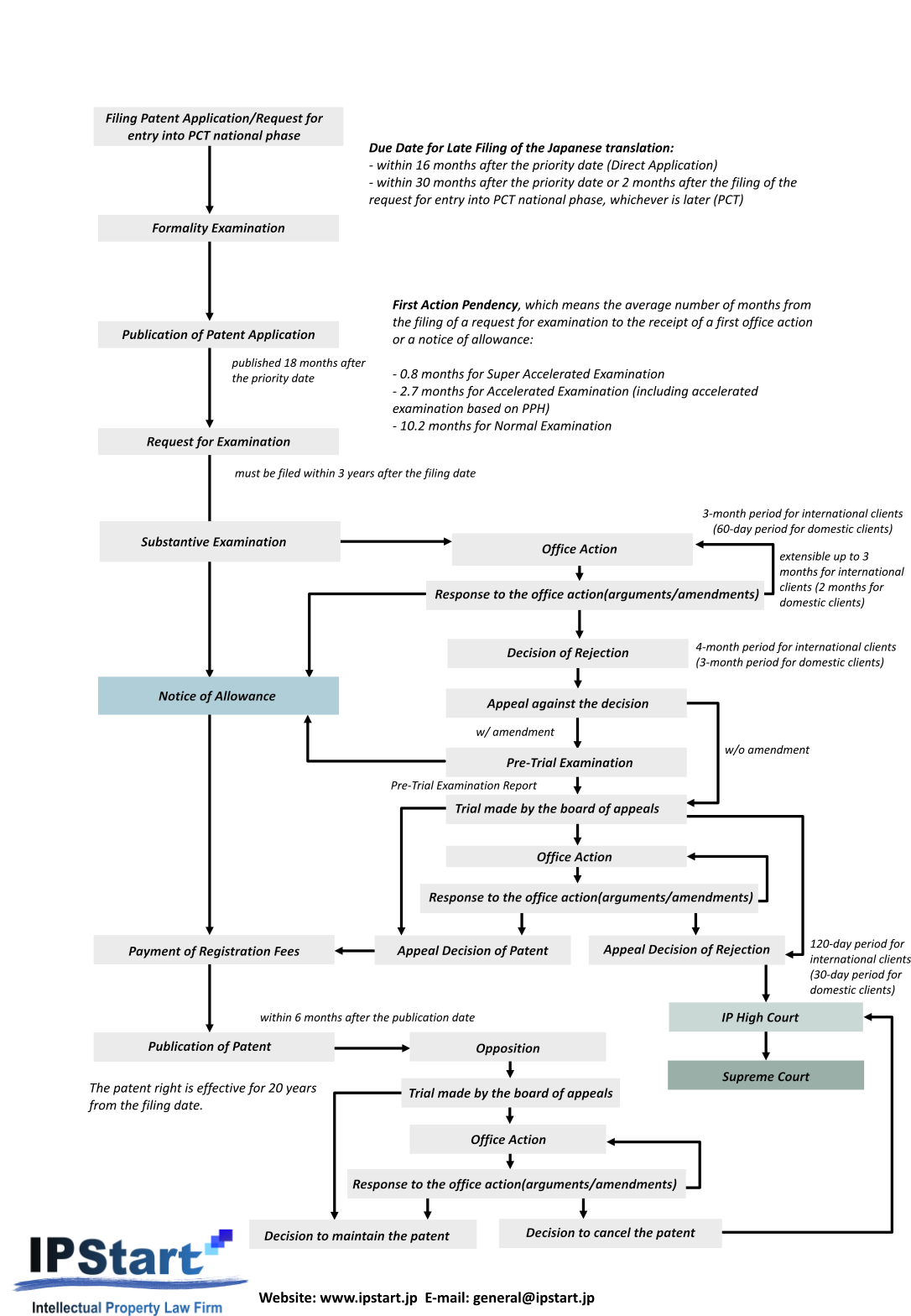Basic Information about Japanese Patent Applications

A PDF version of this image is available here. You may use it for commercial purposes, but please do not remove our logo when using the image. We retain all copyrights related to the image.
Disclaimer: While IPStart makes every effort to ensure the accuracy of the information, it does not guarantee or give any warranty as to the accuracy, timeliness or completeness of any information or material on our website.
Filing a New Patent Application/Request for Entry into PCT National Phase

Applicants need to submit an application form, a specification, claims, an abstract, and drawings (optional) to the JPO.
If Applicants wish to claim priority under the Paris Convention from a basic patent application filed outside Japan, the above documents must be submitted within 12 months after the earliest priority date.
Meanwhile, it is admissible to submit foreign-language documents (i.e., a specification, claims, an abstract, and drawings written in a foreign language) at the time of filing so as to ensure the filing date.
In this case, Applicants must submit the Japanese translations of these documents within 16 months after the earliest priority date.
In case of a PCT application entering the national phase in Japan, Applicants must file a request for entry into PCT national phase to the JPO within 30 months after the earliest priority date.
Where Applicants file the request for entry within 30 months after the earliest priority date, they need to submit the Japanese translations of the specification, claims, abstract, and drawings within 30 months after the earliest priority date or 2 months after the filing date of the request for entry, whichever is later.
Namely, the due date for late filing of the Japanese translation is as follows:
- within 16 months after the earliest priority date (For Paris Route);
- within 30 months after the earliest priority date or 2 months after the filing date of the request for entry, whichever is later (For PCT route)
A power of attorney is not required for filing a new patent application/PCT national phase entry.
A series of flows of filing a new patent application
- Invention hearing through real or online interview
- Prior art search (if necessary)
- Drafting proposed claims and corresponding effects
- Client’s instruction as to the above
- Drafting a specification and drawings
- Client’s instruction as to the above
- Preparing and filing a new patent application
Request for Examination

A request for substantive examination must be filed with the Patent Office within 3 years after the filing date. In the substantive examination, it is determined whether the claimed inventions meet patentability (novelty, inventive step, etc.).
Applicants may file a request for a super accelerated examination or an accelerated examination.
According to the IP Statistics Report 2024 published by the JPO, a first action (FA) pendency for super accelerated examination is 0.8 months. The FA pendency for accelerated examination (including accelerated examination based on Patent Prosecution Highway (PPH) ) is 2.2 months. The FA pendency means the average number of months from the date of a request for examination to the dispatch date of the first examination result (a first office action or notice of allowance). In the meanwhile, the FA pendency for normal examination is 10.0 months.
In addition, if an applicant is a small or medium-sized enterprise (SME)* or Startup** (including a sole proprietorship) which is not controlled by one or more large enterprises***, they may apply for a reduction in substantive examination fees. The examination fees for SMEs are reduced to 1/2. The examination fees for Startups are reduced to 1/3.
*SME for each industry is defined as follows.
| Type of Industry | Number of regular employees | Capital or Total Investments received | |
| (a) | Manufacturing, construction, transportation, and other industries (excluding industries listed in (b) to (g)) | 300 or less | 300M JPY or less |
| (b) | Wholesale | 100 or less | 100M JPY or less |
| (c) | Service (excluding industries listed in (f) and (g)) | 100 or less | 50M JPY or less |
| (d) | Retail | 50 or less | 50M JPY or less |
| (e) | Manufacture of rubber products (except manufacture of automobile or aircraft tires and tubes and manufacture of industrial belts) | 900 or less | 300M JPY or less |
| (f) | software or information processing service | 300 or less | 300M JPY or less |
| (g) | Hotel | 200 or less | 50M JPY or less |
**Startup is defined as a company with less than 300M JPY in capital or total investments received and less than 10 years in business operation periods. Startup is also defined as a company with less than 20 regular employees (a company with less than 5 regular employees in wholesale, retail or service business).
***If a single large enterprise owns more than 1/2 of the total number of shares or the total amount of capital contributions in a small company, the small company is considered as being controlled by the single large enterprise. Likewise, if plural large enterprises own more than 2/3 of the total number of shares or the total amount of capital contributions in a small company, the small company is considered as being controlled by the plural large enterprises.
Please see the following article about reduction of official fees for SMEs, Startups, and sole proprietors.

Office Action

When an applicant receives from the JPO an office action indicating reasons for refusal concerning the patentability (novelty or inventive step) of the claimed inventions, they are given an opportunity to submit a written opinion and/or amendment in response to the office action. The due date for responding to the office action is set to 3 months from the dispatch date of the office action for international clients, and 60 days from the dispatch date for domestic clients. The due date may be extended up to 3 months for international clients, and 2 months for domestic clients. Failure to respond to the office action will result in a decision of rejection.
For example, if claim 1 is described as CL1 = a1 + a2 + a3 and Cited Reference D1 discloses a1, a2, and a3, then claim 1 will be rejected as a lack of novelty based on D1. If Cited Reference D2 discloses a1 and a2 and Cited Reference D3 discloses a3 and also there is a motivation to combine References D2 and D3, claim 1 will be rejected as a lack of inventive step based on D2 and D3.
In this case, an Applicant may consider amending claim 1 to add an element a4 which is not taught or suggested by D1 to D3 (i.e., CL1′ = a1 + a2 + a3 + a4) and arguing against the novelty rejection based on D1 and inventive step rejection based on D2 and D3. The Applicant may also consider arguing that the examiner’s finding is unreasonable (e.g., the element a3 in D1 does not correspond to the claimed element a3 in CL1) without any claim amendment.
After responding to the first non-final office action, the applicant may receive a second office action (non-final or final office action). If the second office action is made final, it should be noted that the claim amendment is limited under the Japanese patent practice (Art. 17-2(5) of the Patent Law). In particular, it is not allowed to amend a claim to extend its scope.
An online interview with the examiner is also an effective way to address the office action. If a reason for refusal is directed toward a lack of clarity, a lack of support requirement, or a new matter addition, it is also effective to have the examiner review the proposed claim amendment before submitting a formal response. Currently, it is also possible to email the MS-word file of the proposed claim amendment to the examiner.
Please see the article about the basic flow of determining inventive step under Art. 29(2) of the Patent Law.

Please see the article about the amendment requirements under the Japanese patent practice.

Decision of Rejection

An examiner’s decision of rejection is issued when reasons for refusal remain unresolved after a response to the previous office action with arguments and/or amendments.
There are three options to address the examiner’s decision of rejection:
- File an appeal against the examiner’s decision of rejection;
- File a divisional application; or
- File another patent application (only if it has not been published yet).
It may also be possible to file both an appeal against the decision and a divisional application. For example, if the current set of claims includes an allowable claim, the applicant may consider amending an independent claim to incorporate the subject matter of the allowable claim upon filing the appeal against the decision and filing a divisional application based on a set of claims whose scopes are broader than those of the current set of claims in the original application.
After April 1, 2023, if the original application is pending in the appeal stage, Applicants may file a request to stay the substantive examination of the divisional application until the appeal decision of the original application is made.
An appeal against the decision or divisional application must be filed within 3 months after the dispatch date of the decision of rejection. This statutory deadline cannot be extended.
A power of attorney is required for filing a request for appeal against the decision. In this regard, no signature is required on the power of attorney.
Applicants may also apply for a request to accelerate the appeal. The appeal decision for the accelerated appeal was made in about 4 months on average in 2017.
Pre-Trial Examination/Appeal

If an amendment is made upon filing an appeal, a pre-trial examination will be conducted prior to the trial made by the panel of Appeal Examiners. In the pre-trial examination, an examiner who made the decision of rejection conducts a reexamination of the claimed invention to determine whether the reasons for refusal have been resolved or not.
If the examiner determines that the reasons for refusal have been resolved, a notice of allowance will be issued. On the contrary, if he/she determines that the reasons for refusal have not been resolved, the pre-trial examination report will be provided to the Commissioner of the Japan Patent Office. Applicants may file a written comment on the pre-trial examination report.
In many cases, a new office action is issued by the panel of appeal examiners before an appeal decision is made. Generally, the office action issued by the panel is much more detailed than one issued by an examiner. The office action may be several dozen pages long, and also the reasons for refusal indicated by the panel should be carefully studied.
When Applicants receive an appeal decision of rejection, they are given an opportunity to challenge the illegality of the appeal decision by filing a lawsuit for cancellation of the appeal decision with the Intellectual Property (IP) High Court (located at the Business Court in Nakameguro). The statutory deadline for filing the lawsuit is a 120-day period from the receipt of the appeal decision for international clients (a 30-day period from the receipt of the appeal decision for domestic clients).
The success rate of appeals against examiner’s decision of rejection (not including the number of registrations in pre-trial examination) was 78% in 2023. For the past several years, the success rate of appeals has been in the latter half of 70%.
It is noteworthy that the success rate of appeals is high in Japan. This may be due in part to the fact that the scope of claim(s) is narrowed by amendments made in response to an office action issued by the Board of Appeal.
Notice of Allowance

In order for a patent to be granted, Applicants need to pay the patent annuities for the 1st to 3rd years (i.e., registration fees) within 30 days from the dispatch date of the notice of allowance. Patent will be issued after the payment of patent annuities for the 1st to 3rd years as registration fees.
The patent right is effective for 20 years from the filing date.
A divisional application may be filed within 30 days from the dispatch date of the notice of allowance. Generally, it is difficult to substantially extend or change the scope of patented claims through a correction trial or a request for correction during invalidation trial after the patent has been granted. Thus, it may be a better option to file a divisional application in consideration of future disputes.
Opposition

Any person may file an opposition to a patent within six months after the publication date of the patent. For example, anyone may file an opposition to a patent for a lack of novelty or inventive step. The opposition is heard by the panel of trial examiners. If the panel determines that the patent should be canceled for one or more reasons, an office action indicating reasons for cancellation will be sent to a patentee.
The patentee may submit arguments and amendments in response to the office action. The due date for responding to the office action is set to 90 days period from the dispatch date of the office action for international clients, and 60 days from the dispatch date for domestic clients.
In the meanwhile, it should be noted that in a request for invalidation trial which is similar to the opposition, only interested parties (e.g., the defendant in a patent infringement suit) can file the request.
According to the IP Statistics Report 2024 issued by the JPO, the number of patent oppositions in 2023 was 1,411, and the number of patent invalidation trials in the same year was 84. Thus, since the new opposition system is restored in 2015, the number of patent oppositions has increased year by year, while the number of invalidation trials has decreased year by year.
It is considered that oppositions are more user friendly than invalidation trials in terms of dummy request, JPO fees, attorney fees, and other factors, although they must be filed within 6 months from the date of patent publication.
In the meanwhile, it should be noted that an opponent cannot file any further arguments against arguments filed by a patentee. Only the board of appeal and trial can review the patentability of patented claims based on documents filed by the opponent and patentee.
For more information on the latest trends in IPR filings in Japan, please refer to the following page.

Please see the article about practical information on Japanese patent applications.

Our professional fees as well as official fees can be found here.

